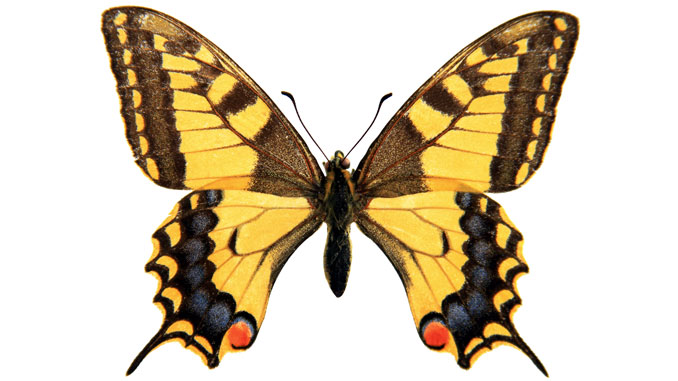
Picture this: Upon waking up to a glorious morning, you pour yourself a cup of coffee and step outside into a garden that’s bursting with a kaleidoscope of butterflies.
Too serene to be true? Au contraire! Butterfly Gardens do exist, and if you’re interested in making this fantasy a reality in your garden, you will need to plant nectar plants as well as host plants for their caterpillars. To ensure that your butterflies have cover from bad weather, plant dense patches of wildflowers or shrubs, or build a brush pile. Decorate your garden with flat stones so that the butterflies have a place to sun their wings. Finally, provide your butterflies with a water source, a muddy space for “puddling”. Listed below are some local butterflies; if you grow their favorite plants, you may just see them in your garden!
Monarch: The most recognizable of our winged-friends, this ambitious migrator crosses California every spring and summer, settling down to breed. Their caterpillars feed almost exclusively on Milkweed, and adult Monarchs also use it for nectar, so planting this is a must if you want to attract this iconic butterfly.
Common Buckeye: While their pattern is beautiful, it’s not just for show: These crafty critters wear their target-shaped pattern to confuse predators. If you’re hoping to see their pretty wings in person, the adults love Curly-Top Gumweed, Rabbitbrush, and Knapweed. To host their caterpillars, choose colorful Snapdragon and Toadflax plants.
Anise Swallowtail: Host plants for this pretty butterfly include everything but the kitchen sink: Parsley, Parsnips, Dill, Carrots, Celery, and Fennel. While the Anise love sweet fennel, if you live in a rural area or are close to farmland, plant with caution—sweet fennel is quick to colonize and hard to get rid of. For the adults, plant Zinnia, Aster, and Butterfly Bush.
Mourning Cloak: If you have trees on your property, you might just be able to attract this gorgeous but picky butterfly. Caterpillars will host on Willow, Elm, Aspen, and Birch trees. While adult Mourning Cloaks prefer tree sap over nectar, specifically that of an Oak tree, they and other butterflies will also feed on a “brew” of rotting fruit. Consider suspending a tray from a tree and cutting up your old fruit to win the heart of this exquisite butterfly.
Not only are butterfly gardens beautiful, but they also help the environment by supporting all kinds of pollinators. In just the past decade, many species of butterfly have dwindled to alarming numbers. By creating a habitat for butterflies in your area, you are encouraging the continued survival of your local butterflies.
For More Information:
CESanJoaquin.ucanr.edu
Monthly Garden Chores:
August:
– Pinch off dead flowers from perennials and annuals to lengthen their summer bloom.
– Sow seeds of perennials in pots for fall planting including Yarrow, Coneflower, and Salvia.
– To prolong bloom into fall, fertilize Begonias, Fuchsias, annuals and container plants, as well as fall-blooming perennials.
September:
– Sow seeds of California Poppies, but do so away from your main garden, as they don’t like competition from other plants.
– Transplant cool-weather annuals such as Pansies, Violas, Fairy Primroses, Calendula, Stocks, and Snapdragons.
– If you plan on sowing a new lawn or reseeding bare spots, do so toward the end of the month.

